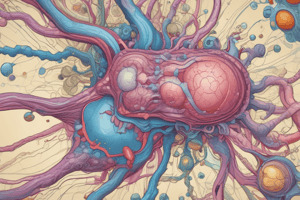Podcast
Questions and Answers
What is the smallest unit of life that can live on its own?
What is the smallest unit of life that can live on its own?
- Molecule
- Cell (correct)
- Organelle
- Tissue
What is the term for a group of atoms bonded together?
What is the term for a group of atoms bonded together?
- Molecule (correct)
- Organelle
- Organ
- Tissue
What is the term for a structure that has a specific job in a cell?
What is the term for a structure that has a specific job in a cell?
- Cell
- Molecule
- Organ
- Organelle (correct)
What is the term for a group of organs that work together to perform a specific function?
What is the term for a group of organs that work together to perform a specific function?
What is the term for a cell with a nucleus?
What is the term for a cell with a nucleus?
Which of the following is an example of an organism?
Which of the following is an example of an organism?
What is the main difference between prokaryotic and eukaryotic cells?
What is the main difference between prokaryotic and eukaryotic cells?
Which of the following is NOT an example of an organ?
Which of the following is NOT an example of an organ?
Which of the following is an example of a tissue?
Which of the following is an example of a tissue?
What is the collective term for the elements Carbon, Hydrogen, Nitrogen, Oxygen, Phosphorus, and Sulfur?
What is the collective term for the elements Carbon, Hydrogen, Nitrogen, Oxygen, Phosphorus, and Sulfur?
Flashcards are hidden until you start studying
Study Notes
Atomic Structure
- The basic units of life are composed of CHNOPS: Carbon, Hydrogen, Nitrogen, Oxygen, Phosphorus, and Sulfur.
Molecular Structure
- A molecule is a group of atoms bonded together, examples include H2O and proteins.
Cellular Structure
- An organelle is a structure within a cell that has a specific job, similar to organs in the human body, examples include the nucleus and mitochondria.
- A cell is the smallest unit of life that can live on its own, and it makes up all living organisms.
Tissue Structure
- A tissue is a group of cells that function together, examples include skin and nervous tissue.
Organ Structure
- An organ is a collection of tissues that work together, examples include the heart and lungs.
Organ System Structure
- An organ system is a group of organs that work together to perform a specific function, examples include the respiratory, digestive, and reproductive systems.
Cellular Classification
- Cells can be classified as Prokaryotic (without a nucleus) or Eukaryotic (with a nucleus).
- Organisms are individual life forms made up of cells.
Atomic Structure
- The basic units of life are composed of CHNOPS: Carbon, Hydrogen, Nitrogen, Oxygen, Phosphorus, and Sulfur.
Molecular Structure
- A molecule is a group of atoms bonded together, examples include H2O and proteins.
Cellular Structure
- An organelle is a structure within a cell that has a specific job, similar to organs in the human body, examples include the nucleus and mitochondria.
- A cell is the smallest unit of life that can live on its own, and it makes up all living organisms.
Tissue Structure
- A tissue is a group of cells that function together, examples include skin and nervous tissue.
Organ Structure
- An organ is a collection of tissues that work together, examples include the heart and lungs.
Organ System Structure
- An organ system is a group of organs that work together to perform a specific function, examples include the respiratory, digestive, and reproductive systems.
Cellular Classification
- Cells can be classified as Prokaryotic (without a nucleus) or Eukaryotic (with a nucleus).
- Organisms are individual life forms made up of cells.
Studying That Suits You
Use AI to generate personalized quizzes and flashcards to suit your learning preferences.




